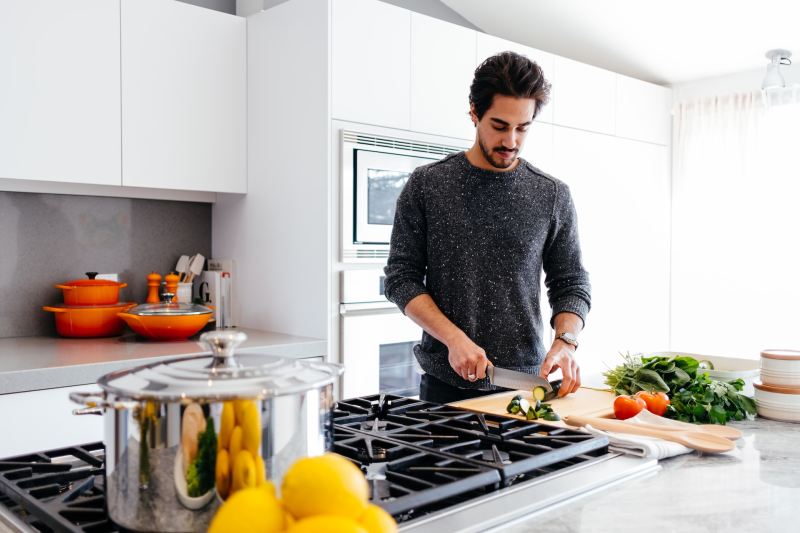Washboard abs and beach-ready bodies are always in style, but having a strong and sculpted core brings additional benefits. Your core muscles are your center of gravity that play a role in almost all of your everyday movements, whether you’re picking up a toddler or cleaning your house. Working out your core muscles is one of the best ways to strengthen your core and tone your abs. Read on for your complete guide to the best core workouts at home — no need for a gym.
The importance of working out your abs

If your abdominal muscles and your other core muscles aren’t strong enough, it could contribute to back pain. An impressive study revealed that two weeks of core stabilization exercises significantly reduced lower back pain. The researchers also concluded that working the core muscles was more effective for treating lower back pain compared to physical therapy.
Research shows that performing core exercises can improve posture and movement control for younger and older adults. Completing daily core strength exercises could also improve independence, balance, and quality of life for older adults. Like your other key muscles, you need to train your abs frequently to see results in how they look and perform. The abs are often overlooked but crucial for peak physical performance.
Harmful belly fat

Research highlights how belly fat around your abdominal area, known as visceral fat, doesn’t just “hide” your abdominal muscles; this type of fat also heightens levels of inflammation in your body and contributes to health problems. A higher waist circumference is linked to more visceral fat.
What you eat matters

While factors like exercise, stress, hormones, and toxicity are all involved with weight loss and body fat composition, you can’t ignore one of the most important factors — what you eat. There’s a direct connection between what you eat and how your abs look, specifically, how much belly fat or visceral fat you have.
For example, eating sugar prompts your body to release the insulin hormone to safely scuttle the sugar away into your cells and prevent dangerously high blood sugar levels in your bloodstream. However, insulin is also your fat-storage hormone that tells your body to store your body fat, so every time you eat a bunch of sugar, the insulin also instructs your body to hold on to fat. This is one of the reasons why consuming too much sugar can increase your body fat, leaving your abs hiding underneath. Studies concluded that added sugar and fructose are among the worst culprits when it comes to increased belly fat. Fructose is a type of sugar common in the standard American diet, usually in the form of high-fructose corn syrup.
Implementing a nutrition plan alongside your workout plan is beneficial. If you have any questions about healthy eating, you can ask your doctor, healthcare provider, or nutritionist.
How often should you work out your abs?

You should aim to work out your abs two or three times every week, with some recovery time in between sessions. It’s a good idea to begin your workouts with ab training first when you’re fresh so you can focus on generating the best possible results.
Researchers have found that higher-volume ab training isn’t necessarily better when it comes to muscle growth and endurance, so you shouldn’t worry about gettubg through lots of crunches every day. Keep in mind that your core muscles need time to recover, and they’re also being worked when you perform other exercises like deadlifts and squats.
The best at-home ab-building exercises

Working out at home provides benefits like privacy, affordability, and convenience. There’s no gym membership fee and you don’t have to share your space with other gym goers or drive anywhere. Here are the best at-home ab-building exercises for you to try that use just your bodyweight, or you can use a lightweight ball or dumbbells and ankle weights.
Seated twist

Performing the seated twist while holding a weight at your center has a significant impact on your abdominal muscles. Seated twists or oblique twists are especially effective for boosting rotational strength and targeting your oblique muscles that run along each side of your abdominal area. You can perform this exercise with or without weights on a chair, on a bench, or on the floor.
How to do a seated twist:
- Sit on a bench or chair with your feet on the floor.
- Keep your feet and your knees about hip-width apart and hold the weight at your center.
- Lengthen your spine and keep your shoulders rolled back.
- Keep your core muscles engaged throughout this exercise.
- Slowly twist your torso toward the right until you feel a good stretch.
- Turn your head to look over your right shoulder and hold the position.
- Return to the starting position and repeat on the other side.
Rotating mountain climber

The rotating mountain climber is a full-body exercise that helps sculpt and strengthen your abs. You perform the mountain climber from the plank position by bringing one knee up to your chest and then kicking it back out behind you as if you’re “running” facing the floor. Rotating your knee at the top of the movement targets your lower abdominals.
How to do the rotating mountain climber:
- Start in the straight plank position with your hands stacked under your shoulders.
- Brace your core and bring your right knee in toward your left elbow to “rotate” your knee at the top of the movement.
- Kick your right knee back behind you to return to the plank position.
- Now, bring your left knee in toward your right elbow.
- Kick your left knee back behind you to return to the plank position.
- Repeat the movement, alternating your legs and accelerating your speed.
Weighted crunch

Holding a weight overhead during a weighted crunch provides more resistance to your rectus abdominis and obliques. The goal is to focus on contracting your abs rather than achieving the biggest range of motion, which can increase your risk of injury. During a crunch, your shoulders should come up off the ground but your lower back should stay touching the ground. An impressive study showed performing crunches between one and three days per week for just six weeks improved abdominal endurance in high school students with no previous training.
How to do a weighted crunch:
- Lie on your back and bend your knees.
- Place your feet flat on the floor and straighten your arms to hold a weight up overhead.
- Slowly lift your shoulders up off the floor until you reach a 30-degree angle, being sure to keep your arms straight and the weight steady overhead.
- Hold the pose for a moment before carefully lowering yourself back to the starting position.
- Repeat for your desired number of reps.
Lying leg raise

The lying leg raise is a simple movement with big results if you focus on engaging your abs and slowing the pace. When your legs reach the top, lift your hips up off the floor and hold the position for a moment before lowering your legs back down. Adding ankle weights increases the resistance, and using an exercise mat or yoga mat is softer to lay on.
How to do a lying leg raise:
- Lay on your back with your legs straight and your hands under your hips or down by your sides.
- Contract your core and slowly raise your legs up together until they’re at a 90-degree angle with the floor. Your knees should be slightly bent.
- Slowly lower your legs back to the starting position until your feet almost touch the floor.
- Repeat for your desired number of repetitions.
Plank

The plank is a simple exercise that uses gravity and muscle tension to keep your body stable and static in a straight plank position. When you hold yourself up off the ground with your arms and toes, you strengthen your abs and core and train other muscle groups, including your shoulders, triceps, and glutes.
How to do a plank:
- Start on the ground with your elbows stacked directly under your shoulders.
- Straighten your legs out behind you and rest your weight on your forearms and toes.
- Engage your glutes and core and create tension in your entire body to maintain the position.
- Your spine and back should form a straight line that’s almost parallel to the floor.
- Hold the position for 10-60 seconds before bringing your knees to the floor to rest.
- Repeat for your desired number of repetitions.
Abs workout

Here’s an example of an effective abs workout routine that should take you around 20 minutes. You can perform this routine before moving on to target your upper body or legs. The idea isn’t to rush through these exercises. Instead, you should try to focus on form and muscle contraction.
Rest for 60 seconds in between sets.
- Seated twist: 3 sets of 10-12 reps (on each side)
- Rotating mountain climber: 3 sets of 10-12 reps (on each side)
- Weighted crunch: 3 sets of 10-12 reps
- Lying leg raise: 3 sets of 10-12 reps
- Plank: 4 sets (hold the pose for 30-60 seconds)
Abs circuit

Circuit training or a workout circuit involves rotating through different exercises for a certain number of repetitions or for a time period with little to no rest. Due to the intensity, most fitness experts suggest completing circuits on their own or before a smaller muscle group session, such as arms. Circuit training targets a specific muscle group to enhance overall physical strength and endurance.
Try not to rest until you’ve performed all five exercises in this effective abs circuit. Rest for 2 or 3 minutes before completing the circuit again. The goal is to complete the circuit three times while resting for 2 minutes between each circuit. This abs circuit should take you around 10 minutes to complete.
- Weighted crunch: Perform for 30 seconds
- Rotating mountain climber: Perform for 30 seconds
- Lying leg raise: Perform for 30 seconds
- Seated twist: Perform for 30 seconds
- Plank: Hold the pose for 1 to 2 minutes
Concluding thoughts

While it takes time and effort, most people start seeing results within the first two months. Seeing improvements in how your abs look and feel motivates you to keep going. Ab training should be straightforward and generate results, especially if you stay consistent and pair your workout plan with a healthy diet.




